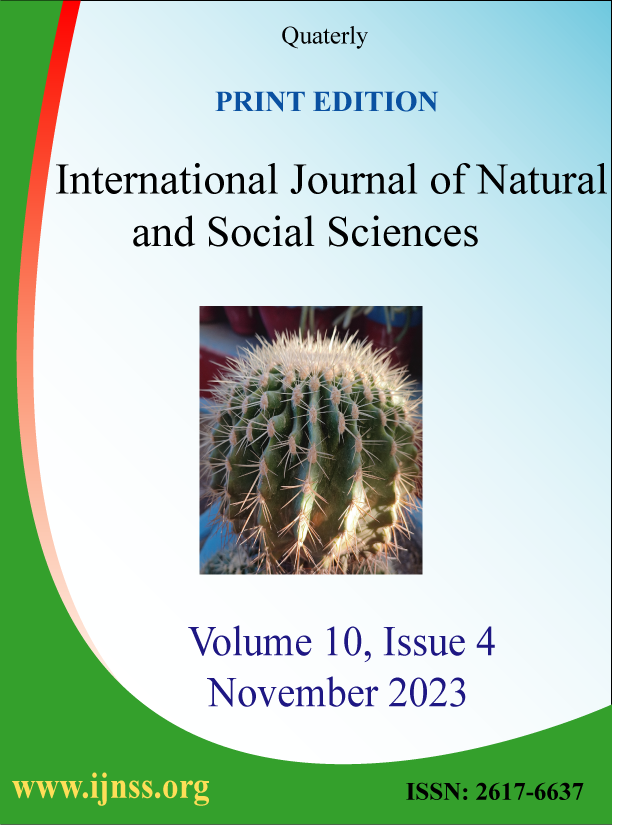Occurrence of Balantidium coli in pig in Mymensingh, Bangladesh
Volume 2, Issue 1, February 2015, Pages 86–89
Md. Abdullah-Al-Hasan1![]()
![]() , Mohammad Afazur Rahman2, Biddut Kumar Saha2, Md. Abdullah-Al-Hasan3, ATM Faiz Khan Rakib2, MM Hussain Mondal1
, Mohammad Afazur Rahman2, Biddut Kumar Saha2, Md. Abdullah-Al-Hasan3, ATM Faiz Khan Rakib2, MM Hussain Mondal1
1Department of Parasitology, Bangladesh Agricultural University, Mymensingh-2202, Bangladesh
2Department of Pharmacology, Bangladesh Agricultural University, Mymensingh-2202, Bangladesh
3Department of Microbiology and Hygiene, Sylhet Agricultural University, Sylhet, Bangladesh
| ABSTRACT | Get Full Text PDF |
The study was conducted to survey the age, sex and month related occurrence of Balantidium coli infection (balantidiasis) in pig in Mymensingh district, Bangladesh. A total of 52 pigs were examined through Stoll’s ova counting technique of which 34.62% pig were found infected with B. coli. Occurrence of B. coli was significantly higher in piglet (50.00%) than in adult (23.33%). During this study, slightly higher prevalence was observed in male than that of female pig. Higher prevalence of B. coli was observed in September month. Overall cysts per gram of faeces were 100-900 and the mean of cysts per gram of faeces was 133.0±5.2. The study suggests that the higher rate of occurrence of B. coli in pig is alarming for both pig and human health which deserve treatment and control of this zoonotic disease in the study area.
Key words: Balantidium coli, pig, Mymensingh, Bangladesh.
![]() Corresponding author. Tel.: +8801717998874
Corresponding author. Tel.: +8801717998874
E-mail address: hasanvet30@gmail.com (MAA Hasan) )
How to cite this article: MAA Hasan, MA Rahman, BK Saha, MAA Hasan, ATMFK Rakib and MMH Mondal (2015). Occurrence of Balantidium coli in pig in Mymensingh, Bangladesh. International Journal of Natural and Social Sciences, 2(1): 86-89.
INTRODUCTION
Pig production is an important part of the economy in many countries. Domestic and wild pigs (Sus scrofa) are susceptible to a wide range of infectious and parasitic diseases. Some of these diseases are specifically limited to pigs while some of the other diseases are shared with other species of wild life and domestic livestock. As the numbers and geographic distribution of wild and domestic swine continue to increase, it is certain that the number of contacts between these swine and domestic livestock will also increase, as well the probability of human exposure to the parasites of swine directly or indirectly.
Balantidium coli, is a common disease of ruminants (cattle, buffaloes, sheep and goats), pig, monkey, chimpanzee, orangutan, guinea pig and man (Samad, 1996). Pigs, in which species the infection is often asymptomatic, are considered to be the most important animal reservoir for human infection (Solaymani-Mohammadi et al., 2004). In fact, although human balantidiasis is considered to be uncommon, its incidence is higher in communities that live in close association with pigs.
Balantidiosis, the disease caused by B. coli infection, has been reported in developing countries such as Brazil, Venezuela, the Philippines, Papua New Guinea, and Iran, and in central Asia and certain Pacific Islands (Solaymani-Mohammadi et al., 2004). The geo-climatic condition of Bangladesh is favourable for the development and survival of various parasites including B. coli (Datta et al., 2004). Several reports on the epidemiological surveys of protozoan parasites in animals and humans are available in Bangladesh and abroad but only a few reports of balantidiasis in man have been published. In India Kaur et al. (2002) reported 2.4% prevalence of B. coli in children. In many developed countries, the data on the prevalence of B. coli were published in an efficient manner as an aid to combat balantidiasis more efficiently. Therefore, a detailed study of the disease pattern is necessary. The aim of the present study is to evaluate the infection rate of B. coli in different areas of Mymensingh district of Bangladesh in relation to age, sex and months of the year.
MATERIALS AND METHODS
Sample collection
Fecal samples of pig were collected from different areas of Mymensingh (Sadar, Muktagachha). Morphological examination was done in the Department of Parasitology, Bangladesh Agricultural University, Mymensingh. Faecal samples from 52 pigs were collected randomly irrespective of age, sex, health, and months of the year from the study areas.
Faecal samples were collected by inserting a moistened finger into the rectum and gently massaging with a rotary motion until the external sphincter relaxes. Fresh faecal samples were collected from the ground immediately after voiding where possible. The samples were then preserved in 10% formalin. The samples were labeled properly with all relevant information and brought to the laboratory for examination as early as possible.
Examination of fecal samples
The fecal samples were proceed and examined by Stoll’s Ova counting technique for counting the number of cysts or trophozoites per gram of fecal samples following their characteristic morphological features as described by Soulsby (1982).
Statistical analysis
Statistical analyses were performed with Statistical Package for Social Sciences (SPSS) programme by using F test. Odds ratio were calculated according to the formula given by Schlesselman (1982).
RESULTS AND DISCUSSION
Overall occurrence of B. coli in pig
The occurence of B. coli was 34.62% in pig. The cyst per gram of faeces was 100-800 with mean of cyst per gram of faeces 133.0±5.2. The present finding is relatively lower than the earlier findings of Mercy, et al. (1989) who reported higher prevalence of B. coli infection (42.00%). The current report is relatively higher than that of Solaymani-Mohammadi et al. (2004) and Permin et al (1999) who recorded 25% and 19% prevalence of B. coli in pig, respectively. The variations between the present and previous findings might be due to difference in the sample size, selection of samples, technique of sample examination, geographical locations, period of study, climatic condition of the research area, managemental factors of pig.
Age and sex related occurance of B. coli in pig
The age specific prevalence of B. coli infection in pig was presented in the Table 1. Prevalence of B. coli in pig was higher in piglet aged <6 months (50.00%) than in adult aged > 6 months (23.33%). The calculated odds ratio reveals that piglet were 3.28 times more likely to be infected by B. coli than that of adult pig (Table 1).
From this study, it was recorded that the prevalence of B. coli was significantly (p<0.01) higher in male (37.50%) than female (30.00%) pig. Male pigs were 1.4 times more vulnerable to balantidiasis than female (Table 1).
It was observed that the age of the pig had significant effect (p<0.01) on the prevalence of B. coli infection. Higher prevalence of balantidiasis was observed in pig aged < 6 months (50.00%) than pig aged >6 months (23.33%). This finding supported by Frederick et al. (2008) who reported higher prevalence of balantidiasis (57.00%) in piglet than adult (55.1%). But this report is in contrast to the previous findings of Hayriye et al. (2009) who reported that higher prevalence was found in piglet (1.4%) than adult (1.5%) and predicted that piglet is more likely to develop balantidiasis than adult. Since both adult and piglet stay together in a flock piglet can get infection easily. Moreover, less developed immune system of piglet may enhance the higher prevalence of balantidiasis in piglet than adult. The prevalence of balantidiasis is more in boar (37.50 %) than sow (30.30%). This report is supported by Polinas et al. (2006) who reported that prevalence of B. coli in boar (12.00%) and in sow (11.17%) in intensive farming. The present finding is differed from that of the earlier finding of Polinas et al. (2000) who reported higher prevalence in sow (36.6%) than boar (13.3%) in extensive farming.
Month related occurrence of B. coli infection
From this study, it was observed that the occurrence of B. coli infection in pig was significantly (p<0.01) higher in September (40.00%) than other months of the year. The present finding is supported by Permin et al. (1999) who reported that the higher prevalence of balantidiasis is found in rainy season (43.34%). However, the highest prevalence in September month may be due the high humidity and heavy rain fall that may increase the chance of contamination of food and water sources by fecal materials containing B. coli cyst.
Table 1
Age related occurrence of B. coli in pig
| Parameters | No. of positive cases | Cyst per gm for stool | Odds ratio | |||
| No. | Prevalence (%) | Range | Mean±SD | |||
| Age | <6 month(n=22) | 11 | 50.00 | 100-600 | 100.0±0.00 | <6 month Vs >6 month = 3.28 |
| >6 month(n=30) | 7 | 23.33 | 100-100 | 240.0±20.7 | ||
| Sex | Female (n=20) | 6 | 30.00 | 100-500 | 225.0±15.8 | Male Vs female = 1.4 |
| Male (n=32) | 12 | 37.50 | 100-800 | 133.0±5.80 | ||
| Months | July(n=20) | 7 | 36.84 | 100-400 | 340.0±19.5 | |
| August(n=15) | 5 | 33.33 | 100-100 | 350.0±19.1 | ||
| September (n=10) | 4 | 40.00 | 100-200 | 220.0±16.4 | ||
| October(n=4) | 1 | 25.00 | 100-500 | 214.0±10.3 | ||
| November (n=3) | 1 | 33.33 | 100-600 | 125.0±4.50 | ||
n= Total number of samples examined.
** Indicates significant (p<0.01)
B. coil is a zoonotic protozoa. The occurrence of B. coli in relation to sex, age of pig at different months of a year could impose a consideration attention of this disease in the study area. Further extensive work in this regard should be needed to assess the zoonotic significance of the disease and to find out a proper control strategies against it in Bangladesh.
REFERENCES
Datta S, Chowdhury MK, Siddiqui MAR and Karim MJ (2004). A retrospective study on the prevalence of parasitic infection in ruminants in selected areas of Bangladesh. Bangladesh Veterinary Journal, 38:25-33.
Frederick L, Schuster L and Ramirez A (2008). Current World Status of Balantidium coli in San Francisco, California, USA. Clinical Microbiology Reviews, 21 (4): 626–663.
Hayriye K, Özden B, Kemal M and Atilla I (2009). Investigation of intestinal parasites in pig feces that are also human pathogens. Türkiye Parazitoloji. Dergisi, 33(3): 218-221.
Kaur R, Rawat D, Kakkar M, Uppal B and SharmaVK (2002). Intestinal parasites in children with diarrhea in Delhi, India. Southeast Asian Journal of Tropical Medicine and Public Health, 33(4):725-729.
Mercy A, Chaneet G and Emms Y (1989). Survey of internal parasites in Western Australian pig herds. Australian Veterinary Journal, 66(1): 4-6.
Permin A, Yelifari L, Bloch P, Steenhard N, Hansen NP and Nansen P. (1999). Parasites in cross-bred pigs in the Upper East region of Ghana. Veterinary Parasitology, 87(1):63-71.
Polinas L, Cocco G, Tanda B, Basciu M, Sanna Coccone GN, Marrosu R, Pipia AP, Nieddu MS, Garippa G and Scala A (2006). Gastro-intestinal parasites of pigs a copromicroscopical investigation in Sardinia. Parasitologia, 48 (14): 313-314.
Samad MA (1996). Balantidiasis. Pashu Palon O Chikitsavidya (Animal Husbandry and Medicine). Lyric- Epic Prokasoni, Mymensingh, 1:765-767.
Schlesseman GV (1946) Case-control studies. 1st edition, Oxford University press, New York, pp. 174-177.
Solaymani-Mohammadi S, Rezaian M, Hooshyar H, Mowlavi1 GR, Babaei Z and Anwar M.A (2004). Intestinal protozoa in wild Boars (Sus scrofa) in western Iran. Journal of Wildlife Diseases, 40 (4): 801-803.
Soulsby EJL (1982). Helminths, Arthropod and Protozoa of Domesticated Animals. 7th edition, Bailliere Tindal and Cassell Ltd., London, pp. 757-759.






